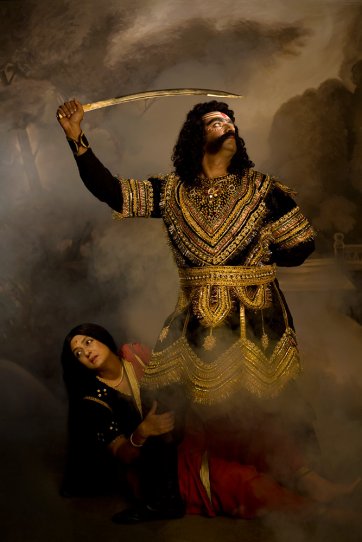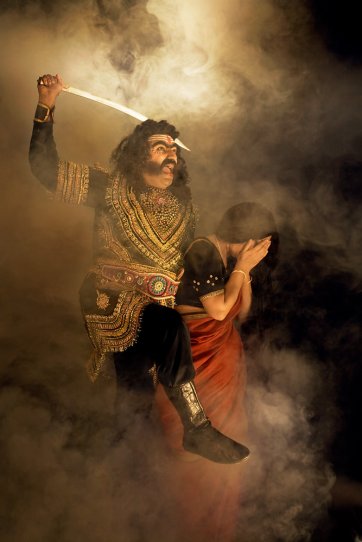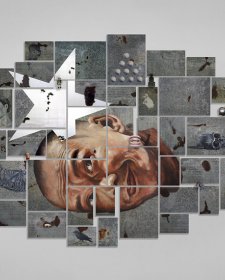Pushpamala’s photographic works are usually created as series, some the artist refers to as projects, others as ‘photo-romances’. Pushpamala uses her own body to perform different roles in these series, which draw from the imagery of popular culture, mythology and historical references from India and elsewhere, using humour, wit and a sharp critical gaze to look at contemporary society.
Pushpamala’s performative photography and videos sometimes function as a kind of installation, where the exhibit may resemble a film or theatre museum or even a movie theatre. She conceives, researches, scripts and designs the mise-en-scenes, working with photographers or photo studios to produce the work where her friends may play supporting roles, or offer their places as locations, which also function as hidden ‘jokes’. She has also made experimental short films that play with film genres. Pushpamala has exhibited internationally and her work is held in many major institutional and private collections. She lives and works in Bangalore and New Delhi, India.
Abduction/Apaharana
In the ‘Wilderness’ chapter of the Indian epic Ramayana, Sita, the pinnacle of feminine virtue, yields briefly to temptation and is abducted by Ravana. Pushpamala seizes this moment and elaborates on it, playing the role of Rama’s demure wife swept away by the demon. High action unfolds in meticulously designed tableaux, recalling the proscenium-framed settings of late nineteenth and twentieth-century Parsi and Kannada theatres. Mist, symbolising dreams and illusions in theatre and film, engulfs the actors. Against faintly visible Arcadian landscapes and golden architecture, Ravana and Sita take on the melodramatic poses of comic-book characters such as Chandamama and Amar Chitra Katha.
One of the most striking differences between this series and Pushpamala’s prior photo-performances is the large size of the photographs (approx. 1 x 1.5 metres). They recall history paintings, and the use of ornate gold frames brings to mind mythological scenes occupying ceilings and overdoors in Baroque and Rococo interiors. And yet, while the genre reference transports the scenarios to a remote story-land, the images also reflect the artist’s body as if in a life-size mirror and thereby address us somatically.
A photograph in which the remote and the familiar combine recalls Michel Foucault’s twofold response to a mirror image. On the one hand, in a mirror we see ourselves where we are, in fact, not, ‘in an unreal, virtual space that opens up behind the surface’. On the other hand, the mirror is also a ‘counter-site’, where the real and the familiar are ‘represented, contested, inverted’.1 Pushpamala’s The Pond exemplifies the mirror’s double bind. The only detail establishing the ‘utopian’ virtuality of the mirror image is a faint reflection of the artist’s hand placed at the lower-right edge of the pool. Everything else in the photograph puzzles. It is hard to work out the camera placement: while the upright reflection of Ravana and Sita suggests the location of the camera behind the actors, the perspectival distortion of the pool suggests that the image is taken from a position opposite the figures, making the upright reflection in fact an upside-down photograph. The (real) lily pads further contribute to the disorientation, hovering like dull, flat shadows in contrast to the two luminous faces and the glitter of Ravana’s garment on the glassy surface of the pool. The inversions establish the mirror image as a separate, tangible ‘counter-site’, to which Pushpamala adds one more incongruity. In contrast to the common knowledge of Sita’s vulnerability at abduction, familiar from Valmiki’s classic narration of the epic, Ravana and Sita exist together here in a space of reverie.
A.K. Ramanujan describes the epic as a ‘pool’ into which one ‘dips ... and brings out a unique crystallisation, a new text with a unique texture and a fresh context’.2 In Pushpamala’s photographic crystallisation, abduction becomes a state of prolonged suspension with unexpected results. When picked up or dragged by the demon, the artist’s body recalls prints by the nineteenth-century artist Raja Ravi Vama, whose compositions in turn reflect Western history paintings. We are also reminded of other ‘Abductions’ from Greco-Roman myths, memorialised in art since the early modern period, from Titian’s Abduction of Europa, to renditions of the abduction of the Sabine women by Poussin, Delacroix and Picasso. Other aspects of the body – its internal glow produced by studio lighting, its poses of surrender and facial expressions more forlorn than fearful – hint at the iconography of the odalisque, the subject of Orientalist paintings and literature, embodying the magic and mystery of distant lands in the context of early-modern, global, cultural encounters. In one image the body arches limply towards the picture frame, as in Henry Fuseli’s Nightmare, combining desire and terror into what can be called a little death (petit mort ). Sita’s moment of crisis thus becomes intervisually dense and ambiguously erotic.
For Foucault, the mirror ‘makes this place that I occupy at the moment when I look at myself in the glass at once absolutely real, connected with all the space that surrounds it, and absolutely unreal, since in order to be perceived it has to pass through this virtual point which is over there’.3 In Pushpamala, the photographic medium creates a similar sense of estrangement from both the self and the cultural mythology it embodies. While the artist’s self becomes distributed and re-assembled as myth, the camera breaks the mythic surface into an uncanny array of competing references. At the same time, the carefully staged images insist on their indexicality: the heft and weight of the body, the facial contortions, the crumpled garments, the stilled mist were all present before the lens. The photograph’s capacity to reveal what Walter Benjamin calls the ‘optical unconscious’ of the visible world produces in the body a new effect, that of mutability.4 It is only when the indexical image of such a body looks back from that virtual point, as Foucault has it, that it reinscribes a sense of self in both the artist and the viewer.
Ajay Sinha
Professor of Art History and Film Studies
Mount Holyoke College, United States
1 Michel Foucault and Jay Miskowiec, ‘Of other spaces’, Diacritics, vol. 16, no. 1, Spring 1986, p. 24.
2 A.K. Ramanujan, ‘Three hundred Ramayanas : Five examples and three thoughts on translation’, in Paula Richman (ed.), Many Ramayanas: The diversity of a narrative tradition in South Asia, Berkeley, Los Angeles and Oxford: University of California Press, 1991, p. 46.
3 Foucault, op. cit., p. 24.
4 Walter Benjamin, ‘A small history of photography’, in One way street and other writings, translated by Edmund Jephcott and Kingsley Shorter, London and New York: Verso, 1997, pp. 242–43.



















